
Mi-28 Havoc – An Unquestionable Power of the Russian Air Force
In today’s modern battlefield, combat vehicles continue to assert their dominance, and one standout performer on the global stage is the Mi-28 attack helicopter. For many militaries, attack helicopters have long been a staple, and among them, the Russian Mi-28 holds a prominent position.
Leading defense experts in the United States have also recognized the formidable capabilities of the Mi-28. Even when compared to similar Western weaponry, the Mi-28 boasts numerous outstanding advantages that set it apart.
The Mi-28 is renowned for its exceptional firepower, maneuverability, and high survivability, particularly the next-generation Mi-28N, which has earned praise from military experts as one of the best attack helicopters in existence today.
The Birth of Mi-28
The Mi-28, known by the NATO codename “Havoc,” is a modern combat helicopter designed to engage armored and unarmored combat vehicles, low and slow-flying airborne targets, and other threats on the battlefield. Its development traces back to the 1980s in the Soviet Union and Russia, with the maiden flight taking place on November 10, 1982, and it entered service in 2008.
The Mi-28’s journey began in 1972, following the completion of the Mil Mi-24, when the Soviet Union sought the development of a high-performance attack helicopter. This new helicopter was intended to combat enemy tanks and helicopters while also supporting helicopter landing operations.
Design work on the Mi-28 started in 1980 under the guidance of Marat Tishchenko, resulting in two prototypes and successful trials by 1984. However, in October 1984, the Soviet Air Force opted for the more advanced Kamov Ka-50 as its new anti-tank helicopter, causing the Mi-28 project to take a back seat.

The Rise of Mi-28N Night Havoc
In August 1996, Mil unveiled a prototype of the Mi-28N Night Havoc, capable of operating both day and night. Production of the Mi-28N began in April 2004, and it entered flight testing with the Russian Air Force in June 2005. The first serial Mi-28N was delivered to the Russian army on June 5, 2006, with plans to replace the Mi-24 entirely by 2015.
Mil also developed an export variant of the Mi-28N, the Mi-28NE, and a simpler day helicopter variant, the Mi-28D, without radar and forward-looking infrared systems. Today, nearly 70 improved Mi-28N attack helicopters are in service with the Russian army, actively marketed for export to other nations.

Design and Survivability
The Mi-28’s design draws similarities to the well-known Mi-24 Hind, featuring separate tandem cockpits for the pilot and navigator officer under individual canopies. Its fuselage includes a bay with a hatch door capable of accommodating three people for the rescue of downed aircrew.
The helicopter’s main rotor utilizes elastomeric bearings and composite material blades, while the tail rotor employs a biplane configuration with independently controlled X-shaped blades. Its landing gear is non-retractable tricycle tailwheel type, with energy-absorbing mechanisms for crash landings or low-altitude vertical falls.
In terms of survivability, the Mi-28 boasts a fully armored cabin, including a windshield capable of withstanding impacts from 7.62mm and 12.7mm bullets, as well as 20mm shell fragments. The crew can survive a vertical fall of up to 12 meters per second, and when altitude allows, parachute operations are possible.

Sensors and Armament
The Mi-28 is equipped with a comprehensive electronic combat system, including a microwave radar antenna above the rotor head and a forward-looking infrared system. This system allows the helicopter to hover under cover, with just the radar head exposed.
The integrated combat system provides real-time data on the helicopter’s location, flight systems, and target information via cockpit liquid crystal displays. Night vision goggles and a helmet-mounted target designation system enhance the pilot’s capabilities, enabling nap-of-the-earth flight missions in various conditions.
The Mi-28 is armed with a 30mm Shipunov 2A42 autocannon housed in a turret under the nose, with 150-round ammunition boxes co-mounted for a total of 300 rounds. Additionally, it can carry Ataka missiles, S-13 rockets, R-73 air-to-air missiles, Kh-25 air-to-surface missiles, and up to 500kg of aerial bombs.
Future Developments and Global Presence
Russia has been developing the Mi-28NM, an improved version featuring low radar signature, extended range, advanced weapons control systems, air-to-air engagement capability, and increased top speed. This variant includes a new helmet imaging and targeting system designed for enhanced target acquisition.
While Russia remains the primary operator of the Mi-28 Havoc, export versions have found their way to various countries, including North Korea, Iraq, and potentially India, Algeria, and Venezuela.
In summary, the Mi-28 Havoc stands as an undeniable powerhouse in the Russian Air Force arsenal, showcasing its capabilities as a modern combat helicopter capable of tackling a wide range of battlefield challenges. Its evolution continues, ensuring it remains a force to be reckoned with on the global stage.





